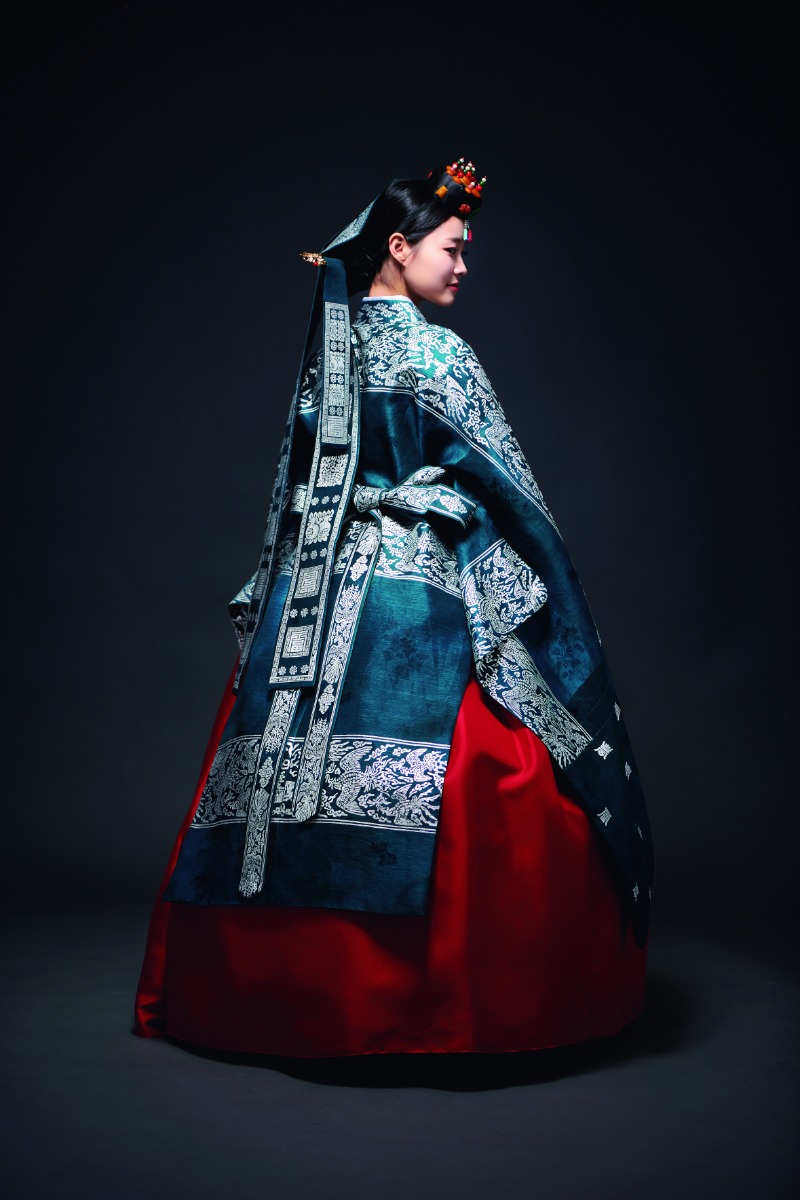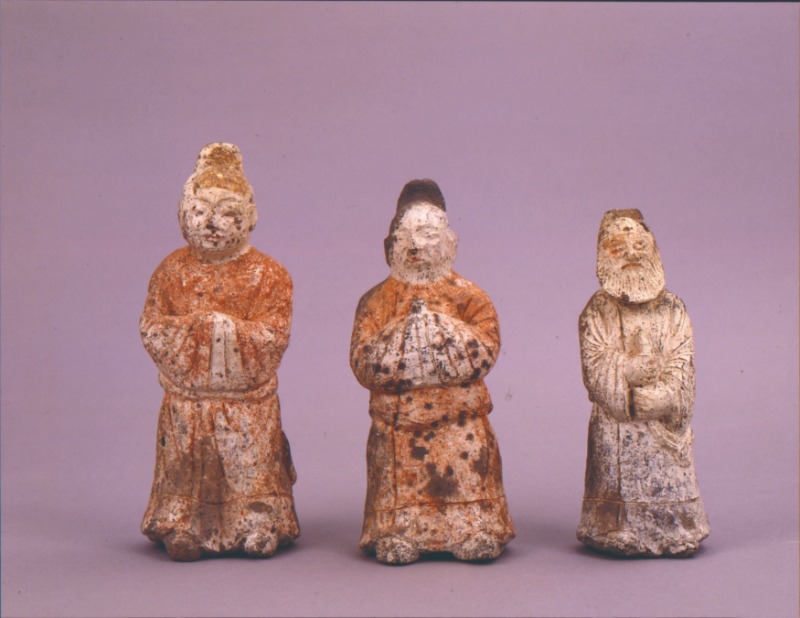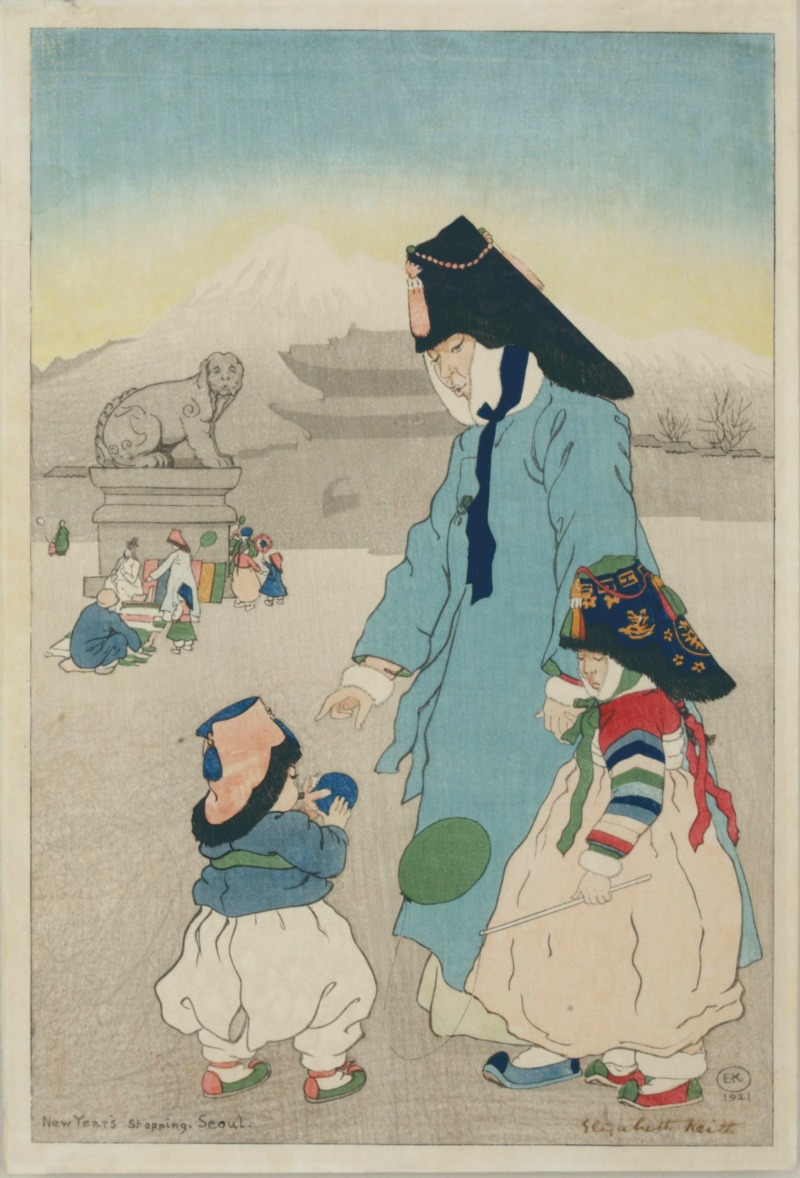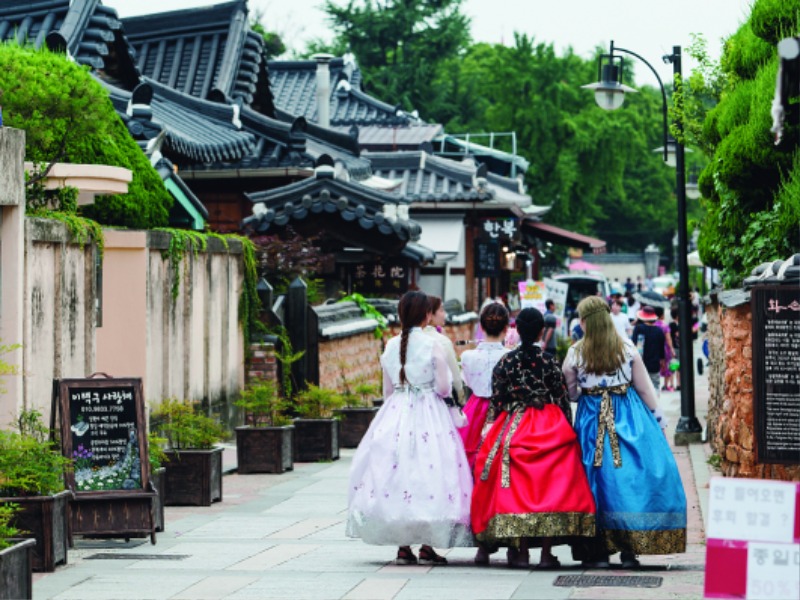In July 2022, the Cultural Heritage Administration designated hanbok saenghwal as National Intangible Cultural Heritage. The combination of “hanbok” (literally “Korean clothing”) and “saenghwal” (living), encompasses the array of social customs and culture related to Korea’s national attire.

A woman wearing wonsam, the attire of royalty and and noblewomen during the Joseon Dynasty. Women in the lower social order were allowed to wear the garment only on their wedding day. Depending on the status of the wearer, the colors differed, with yellow and red worn by royalty and green by ordinary people. Today, wonsam are made with various colors and decorative designs.
ⓒ TongRo Images
Most countries have traditional clothing that reflects their geography, history, religion, and values. Some notable examples are Japan’s kimono, China’s cheongsam and hanfu, Mongolia’s deel, Vietnam’s áo dài, and India’s sari.
Korea has hanbok. Like the traditional garments and sartorial culture of other countries, hanbok has also undergone distinctive changes in its form, production, and distribution. What used to be everyday wear is now worn only on special occasions. Nonetheless, the distinctive cultural identity derived from wearing hanbok is still very much a part of Koreans’ lives today.
Cradle to Grave
The history of hanbok spans some 2,000 years. Depictions of the traditional attire can be found in ancient tomb murals of Goguryeo (37 BCE–668 CE) and on clay figures made by the people of Silla (57 BCE–935 CE). The basic structure of hanbok emerged during the Three Kingdoms period (57 BCE–668 CE), when the Korean peninsula was divided among the states of Goguryeo, Baekje, and Silla. It then underwent numerous changes throughout the following Unified Silla (676–935), Goryeo (918–1392), and Joseon (1392–1910) dynasties, and the Japanese occupation (1910–1945). It was during the mid- and late Joseon dynasty that the archetype of the traditional hanbok as we know it today was established. The term “hanbok” was first used to distinguish the native clothing from Western-style clothing, which was introduced to Korea in the late 19th century. The origin of the word, however, is unknown.
The types and form of hanbok vary depending on gender, age, season, and occasion. Hanbok for everyday wear consists of baji (trousers) and jeogori (top) for men, and chima (skirt) and jeogori for women. Depending on the destination and occasion, an outer robe may be worn. Whatever the type or style, hanbok is characterized by the beautiful contours d by the harmony of straight and curved lines, elegant colors, and the overall graceful appearance. As the garments are loose-fitting, the shape of the wearer’s body is not discernable.
Although hanbok is no longer part of the everyday wardrobe, the occasions when it is worn are vivid reminders that they are still an integral part of Koreans’ cultural identity. Koreans don traditional garb on important milestones in life, from birth and weddings to funerals. They also wear it on traditional Korean holidays, such as Seollal (Korean Lunar New Year) and Chuseok (Harvest Moon Festival), when they conduct ceremonies and play folk games.
The first garment a newborn baby wears in Korea is called baenaet jeogori. It is an upper garment made from cotton and has hardly any seams, to minimize irritation of the baby’s delicate skin. Koreans throw a big party to celebrate a child’s first birthday (dol), and on the day the child is dressed in ceremonial garments called dolbok, which are adorned with characters and patterns that symbolically repel evil spirits and express wishes for health and longevity.
Hanbok is also ubiquitous at weddings. Although most brides and grooms wear a Western-style wedding dress and suit these days, it is still the custom for parents to wear traditional clothes, and some guests will also do the same out of courtesy. Couples who opt for a traditional wedding, will naturally don hanbok, too.
When Koreans die, they are dressed in burial clothes called suui. A characteristic of suui is that they are sewn without tying knots in the thread, as knots were thought to prevent the soul of the dead from communicating with their children. Some prepare the suui in advance, believing that it will ensure a long and healthy life. Finally, people also wear hanbok when performing ancestral rites.

Clay figures unearthed during the 1986 excavation of an ancient tomb (late 7th century-early 8th century) located in Yonggang-dong, Gyeongju in North Gyeongsang Province. The realistic depiction of the hair and garments offers insight into the clothing people wore at the time.
ⓒ Cultural Heritage Administration
Hanbok Today
In the past, Koreans purchased fabric before major holidays and made new hanbok at home. Today, most people purchase ready-to-wear hanbok or have them custom-made at a designer shop. Hanbok worn on special occasions goes by different names, including seolbim, worn on the Korean Lunar New Year; danobim on Dano, a holiday falling on the fifth day of the fifth lunar month; and chuseokbim on Chuseok, which falls on the fifteenth day of the eighth lunar month. These garments are more than just clothing. They embody ardent wishes for good health and well-being, and for peace and happiness in the family.
In the past, social position, gender, and age had to be considered when choosing the colors and patterns to be worn. Now, there are no such constraints; people can wear whatever design they like. Many hanbok brands offer modern variations of the traditional dress, which are more practical for today’s lifestyle.
There has been steady interest in preserving and transmitting the cultural tradition of wearing hanbok. These days, the younger generation consider wearing hanbok a fun experience that allows them to express their individuality and tastes.
In the quaint old neighborhood of Insa-dong and the traditional Korean village Bukchon in the heart of Seoul, it is easy to spot young people and foreign tourists roaming the streets dressed up in traditional clothes, usually from one of the many hanbok rental shops. Fashion designers also draw inspiration from traditional attire, incorporating key hanbok features with modern interpretations.

“New Year’s Shopping in Seoul” (1921), a woodblock print by British artist Elizabeth Keith. It portrays a woman and her two children on an outing dressed up in seolbim. After visiting Korea for the first time in 1919, Keith returned several times and captured the customs and daily lives of Koreans in her prints.
ⓒ National Folk Museum of Korea
Continuing to Evolve
Celebrities, who tend to have a huge influence on young people, often attract attention by wearing hanbok. World-famous K-pop acts BTS and BLACKPINK d a sensation when they wore modified hanbok in music videos and at concerts. This sparked tremendous interest in traditional Korean clothing among K-pop fans around the world and helped to raise its global profile.
K-dramas are also having a major impact. In April 2022, a New York Times article shed light on hanbok and the changes that occurred over time, as observed in the Apple TV+ series “Pachinko.” It began by saying that “the evolution of the Korean hanbok is a lens into the history of the country,” and in introducing the history and variety of hanbok, commented that hanbok “is as beautiful as it is functional.” It also stated that “contemporary designers continue to take great inspiration from the garment,” which has reflected variations and styles over its long history.
The Korean government is actively implementing policies to help preserve the tradition of wearing hanbok. In 1996, the Ministry of Culture, Sports and Tourism designated October 21 as “Hanbok Day.” The ministry also holds events each year to arouse public interest and further promote the cultural value of hanbok. Local governments have followed and give incentives to put on traditional attire, for instance, free entrance to famous sightseeing spots.
Culture encompasses all aspects of people’s ways of life, and as such, is bound to change with the times and environment. This also applies to the tradition of wearing hanbok. It has evolved and changed over Korea’s long history and will continue to do so in the future.

Young women explore Jeonju Hanok Village dressed in modernized hanbok. In the vicinity of royal palaces in downtown Seoul and traditional Korean villages in provincial areas, there are many shops that rent out hanbok that have been refashioned to cater to the tastes of young people.
ⓒ Korea Tourism Organization
Doh Jae-kee Reporter, The Kyunghyang Shinmun